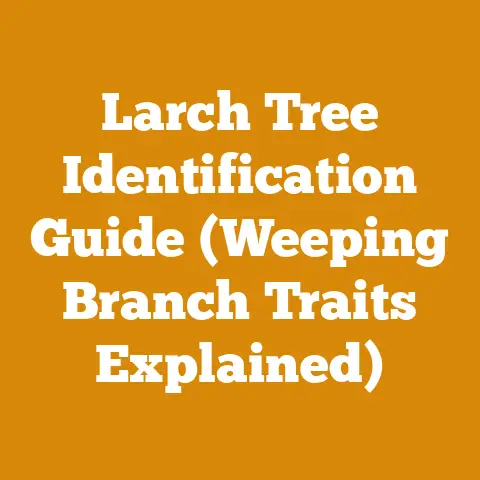Which Wood Burns the Hottest? (Top 15 BTU Secrets Revealed)
Okay, here we go. I’m putting on my boots, grabbing my axe, and diving deep into the world of firewood. Let’s get to the heart of the matter: which wood burns the hottest!
The Firewood Face-Off: Unveiling the BTU Champions
Ever stood shivering on a frosty evening, desperately trying to coax a flame from a stubborn pile of wood? I have. More times than I care to admit. It’s a humbling experience, especially when you know your neighbor’s fireplace is roaring with cozy warmth. That’s when I realized understanding BTU (British Thermal Units) and wood types was more than just a hobby – it was a survival skill!
The challenge? Not all wood is created equal. Some species are like fiery dynamos, packing a serious heat punch, while others are…well, let’s just say they’re better suited for kindling. The key is knowing the difference.
Key Takeaways:
- BTU is King: We’ll explore what BTU means for firewood and why it’s the ultimate measure of heat output.
- Hardwood vs. Softwood: I’ll break down the fundamental differences and bust some common myths.
- Top 15 BTU Powerhouses: We’ll rank the hottest burning woods, from the undisputed champion to some surprisingly effective contenders.
- Seasoning is Essential: Learn why properly seasoned wood is crucial for efficient burning and maximum heat.
- Beyond the BTU: We’ll consider factors like smoke, sparks, and ease of splitting to give you a complete firewood profile.
- Safety First: Crucial safety tips for cutting, splitting, and storing firewood.
BTU: The Secret Language of Firewood
Before we dive into specific wood types, let’s decode BTU. Simply put, BTU measures the amount of heat required to raise the temperature of one pound of water by one degree Fahrenheit. In the firewood world, it’s the gold standard for comparing heat potential. The higher the BTU, the more heat a given amount of wood will produce.
Think of it like this: BTU is the fuel efficiency of firewood. A wood with a high BTU rating is like a fuel-efficient car – it gives you more miles (or, in this case, heat) per gallon (or cord).
Hardwood vs. Softwood: The Great Debate
The first distinction we need to make is between hardwoods and softwoods. Generally speaking, hardwoods are denser and burn hotter and longer than softwoods. This is because they have a more complex cellular structure. However, there are exceptions to this rule.
- Hardwoods: Typically deciduous trees (trees that lose their leaves annually). Examples include oak, maple, ash, and hickory.
- Softwoods: Typically coniferous trees (trees that have needles and cones). Examples include pine, fir, spruce, and cedar.
I’ve seen plenty of folks swear by hardwoods, claiming softwoods are only good for starting fires. While there’s some truth to that, it’s not the whole story. Some softwoods, like Douglas fir, can provide a decent amount of heat, especially when properly seasoned.
The Top 15 Hottest Burning Woods: BTU Secrets Revealed!
Alright, let’s get down to business. Here are the top 15 woods, ranked by their approximate BTU content per cord (a cord is a stack of wood measuring 4 feet high, 4 feet wide, and 8 feet long). Keep in mind that these are average values, and actual BTU content can vary depending on factors like moisture content, tree age, and growing conditions.
(Note: BTU values are approximate and can vary. Always consult local resources for accurate data.)
- Osage Orange (Hedge): 32.9 Million BTU/Cord
- The undisputed champion. This stuff is legendary. It burns incredibly hot and long, but it can be a pain to split due to its twisted grain. I once tried to split a particularly gnarly piece and nearly threw out my back!
- Hickory (Various Species): 27.7 Million BTU/Cord
- A fantastic all-around choice. Hickory burns hot, clean, and produces a pleasant aroma. Plus, it’s relatively easy to split. I often use hickory for cooking, as it imparts a wonderful smoky flavor.
- Black Locust: 26.8 Million BTU/Cord
- Another top contender. Black locust is incredibly dense and rot-resistant, making it a durable and long-lasting firewood. It can be a bit difficult to ignite, but once it gets going, it burns like a furnace.
- Beech: 24 Million BTU/Cord
- Beech is a great firewood option, especially American Beech. It is easy to split, burns fairly clean, and produces a decent amount of heat.
- Oak (Red & White): 24.6-28 Million BTU/Cord
- The king of firewood for many. Oak is readily available in many regions and offers a good balance of heat output, burn time, and ease of splitting. White oak generally burns slightly hotter than red oak. The only downside is that it needs a longer seasoning time (at least a year).
- Sugar Maple: 24 Million BTU/Cord
- A close cousin to oak in terms of heat output. Sugar maple is also relatively easy to split and burns with a clean flame. I love the subtle sweetness of maple smoke.
- Ash (White): 23.6 Million BTU/Cord
- Ash is another excellent choice. It splits easily, seasons quickly, and burns hot with minimal smoke. The saying goes, “Ash wood green is fit to burn,” which speaks to its relatively low moisture content even when freshly cut.
- Birch (Yellow): 20.2 Million BTU/Cord
- While not as hot as the top contenders, yellow birch is still a solid choice. It burns with a bright flame and a pleasant aroma. It’s also relatively easy to ignite.
- Cherry (Black): 19.8 Million BTU/Cord
- Black cherry is known for its beautiful color and distinctive aroma. It burns relatively hot and clean, but it can produce some sparks. I always keep a screen in front of the fireplace when burning cherry.
- Red Elm: 19.6 Million BTU/Cord
- Red Elm is known for its high wind resistance and is considered a hard and dense wood. It is more difficult to split than other firewood.
- Douglas Fir: 17 Million BTU/Cord
- A softwood that punches above its weight. Douglas fir burns surprisingly hot, especially when properly seasoned. It’s also relatively easy to find in many areas.
- Tamarack/Larch: 16.8 Million BTU/Cord
- This softwood is very dense and burns hot. It is also very resinous, so it should be burned in a closed stove.
- Pine (Various Species): 12-17 Million BTU/Cord
- Pine gets a bad rap, but it can be a decent option, especially if you need a quick burst of heat. It burns fast and produces a lot of smoke, so it’s best used in a well-ventilated fireplace or wood stove. I often use pine for shoulder season fires when I don’t need a long-lasting burn.
- Cedar (Various Species): 13 Million BTU/Cord
- Cedar is prized for its aromatic properties and insect-repelling qualities. It burns with a pleasant fragrance, but it doesn’t produce a lot of heat. I often use cedar kindling to start fires.
- Poplar: 13 Million BTU/Cord
- Poplar is the lowest on the list, but still a good wood to burn. It is lightweight and easy to split.
The Importance of Seasoning: From Green to Gold
No matter how high the BTU rating of your wood, it won’t burn efficiently if it’s not properly seasoned. Seasoning is the process of drying out the wood to reduce its moisture content. Green wood (freshly cut wood) can contain up to 50% moisture, which significantly reduces its heat output and increases smoke production.
Why Seasoning Matters:
- Increased Heat Output: Dry wood burns hotter and more efficiently.
- Reduced Smoke: Dry wood produces less smoke, which is better for your health and the environment.
- Easier Ignition: Dry wood is much easier to light.
- Reduced Creosote Buildup: Creosote is a flammable residue that can accumulate in your chimney, increasing the risk of a chimney fire. Burning dry wood reduces creosote buildup.
How to Season Firewood:
- Split the Wood: Splitting the wood increases the surface area exposed to air, speeding up the drying process.
- Stack it Properly: Stack the wood in a single row, off the ground, with plenty of air circulation. I like to use pallets to keep the wood off the ground.
- Choose a Sunny and Windy Location: Sunlight and wind help to dry the wood more quickly.
- Cover the Top: Cover the top of the stack with a tarp to protect it from rain and snow, but leave the sides open for ventilation.
- Be Patient: Seasoning takes time. Hardwoods typically need at least 6-12 months to season properly. Softwoods can season more quickly, but still benefit from at least 6 months of drying time.
I remember one winter when I was short on seasoned firewood. I tried to burn some green oak, and it was a disaster. It smoked like a chimney, produced very little heat, and left a thick layer of creosote in my flue.
Beyond the BTU: Other Factors to Consider
While BTU is the most important factor, it’s not the only thing to consider when choosing firewood. Here are some other factors to keep in mind:
- Smoke Production: Some woods produce more smoke than others. Oak, ash, and maple are generally considered to be low-smoke woods, while pine and cedar tend to be smokier.
- Sparking: Some woods, like cherry and pine, are prone to sparking. This can be a safety hazard if you don’t have a screen in front of your fireplace.
- Ease of Splitting: Some woods are easier to split than others. Ash, maple, and birch are generally easy to split, while oak, hickory, and elm can be more challenging.
- Availability: The best firewood is the one that’s readily available in your area. Consider what species are common and affordable in your region.
- Aroma: Some woods have a distinctive aroma when burned. Cherry, cedar, and apple are known for their pleasant scents.
Safety First: Handling Firewood Responsibly
Firewood preparation can be a rewarding but potentially dangerous task. Always prioritize safety when cutting, splitting, and handling wood.
Essential Safety Tips:
- Wear Proper Safety Gear: This includes safety glasses, gloves, hearing protection, and sturdy boots.
- Use the Right Tools: Use a sharp axe or maul for splitting wood. Make sure your chainsaw is in good working order and that you know how to use it safely.
- Work in a Safe Area: Choose a clear, level area for cutting and splitting wood. Keep children and pets away from the work area.
- Be Aware of Your Surroundings: Watch out for overhead hazards, such as tree limbs. Be mindful of your footing, especially in wet or icy conditions.
- Lift Properly: Lift with your legs, not your back. Avoid twisting or bending while lifting.
- Store Firewood Safely: Stack firewood away from your house and other structures. This will help to prevent the spread of fire in case of a wildfire.
- Inspect Your Chimney Regularly: Have your chimney inspected and cleaned annually to prevent creosote buildup.
I’ve had a few close calls over the years, and I’ve learned that it’s always better to be safe than sorry. A moment of carelessness can lead to a serious injury.
The Environmental Impact of Firewood
It’s important to consider the environmental impact of burning firewood. While firewood is a renewable resource, it’s not without its drawbacks.
Environmental Considerations:
- Air Pollution: Burning firewood releases pollutants into the air, including particulate matter, carbon monoxide, and nitrogen oxides. These pollutants can contribute to respiratory problems and other health issues.
- Carbon Emissions: Burning firewood releases carbon dioxide into the atmosphere, contributing to climate change. However, if the wood is harvested sustainably, the carbon emissions can be offset by the carbon absorbed by the growing trees.
- Deforestation: Unsustainable logging practices can lead to deforestation and habitat loss.
Sustainable Firewood Practices:
- Harvest Wood Sustainably: Choose wood that has been harvested from sustainably managed forests.
- Burn Dry Wood: Burning dry wood reduces smoke and pollution.
- Use an Efficient Wood Stove: Modern wood stoves are much more efficient and produce less pollution than older models.
- Consider Alternative Heating Options: Explore alternative heating options, such as solar, geothermal, or heat pumps.
Case Study: Optimizing Firewood Production in a Small Workshop
I recently consulted with a small woodworking shop that was looking to supplement its income by selling firewood. They had access to a steady supply of hardwood logs, but they were struggling to produce firewood efficiently.
Challenges:
- Labor-Intensive Process: Cutting and splitting wood by hand was slow and tiring.
- Inconsistent Sizing: The firewood was not consistently sized, making it difficult to stack and sell.
- Limited Seasoning Capacity: They didn’t have enough space to properly season a large quantity of wood.
Solutions:
- Invested in a Log Splitter: A hydraulic log splitter significantly reduced the amount of labor required for splitting wood.
- Built a Firewood Processor: A firewood processor automated the cutting and splitting process, producing consistently sized firewood.
- Improved Seasoning Practices: They built a series of raised platforms to stack the wood off the ground and improved air circulation.
Results:
- Increased Production: Firewood production increased by 500%.
- Improved Quality: The firewood was more consistently sized and seasoned.
- Increased Profits: The shop was able to generate a significant amount of additional income by selling firewood.
This case study demonstrates that even a small workshop can significantly improve its efficiency and profitability by investing in the right tools and implementing best practices.
The Future of Firewood: Innovations and Trends
The world of firewood is constantly evolving. Here are some of the latest innovations and trends:
- Firewood Processors: These machines automate the entire firewood production process, from cutting and splitting to loading and stacking.
- Kiln-Dried Firewood: Kiln-drying firewood reduces its moisture content to extremely low levels, resulting in a hotter, cleaner burn.
- Compressed Firewood: Compressed firewood is made from wood waste that has been compressed into dense logs. It burns longer and produces less smoke than traditional firewood.
- Biomass Heating Systems: Biomass heating systems burn wood pellets or chips to heat homes and businesses. These systems are more efficient and environmentally friendly than traditional wood stoves.
Regional Variations: Firewood Preferences Around the World
Firewood preferences vary widely depending on the region. In some areas, oak is the preferred choice, while in others, birch or pine are more common. Factors such as climate, availability, and cultural traditions all play a role in shaping these preferences.
- North America: Oak, maple, ash, and hickory are popular choices in many parts of North America.
- Europe: Birch, beech, and oak are commonly used in Europe.
- Asia: Pine, cedar, and oak are popular in Asia.
Actionable Conclusions: Your Next Steps to Firewood Mastery
So, what have we learned? Choosing the right firewood is a combination of understanding BTU content, considering other factors like smoke and ease of splitting, and practicing proper seasoning techniques.
Here’s what you can do next:
- Identify the Best Firewood Options in Your Area: Research which species are readily available and affordable in your region.
- Start Seasoning Your Wood Now: Don’t wait until winter to start preparing your firewood. The sooner you start, the better.
- Invest in the Right Tools: A good axe, maul, or log splitter can make a huge difference in your firewood production efficiency.
- Prioritize Safety: Always wear proper safety gear and follow safe work practices.
- Consider the Environmental Impact: Choose wood that has been harvested sustainably and burn it efficiently.
Final Thoughts: The Warmth of Knowledge
Firewood isn’t just about heat; it’s about connection. It’s about connecting with nature, with tradition, and with the simple pleasures of a crackling fire on a cold night. By understanding the science behind firewood and practicing responsible harvesting and burning techniques, we can enjoy the warmth and comfort of a wood fire for years to come.
Now, if you’ll excuse me, I’ve got a stack of oak that needs splitting. Stay warm, and happy burning!






